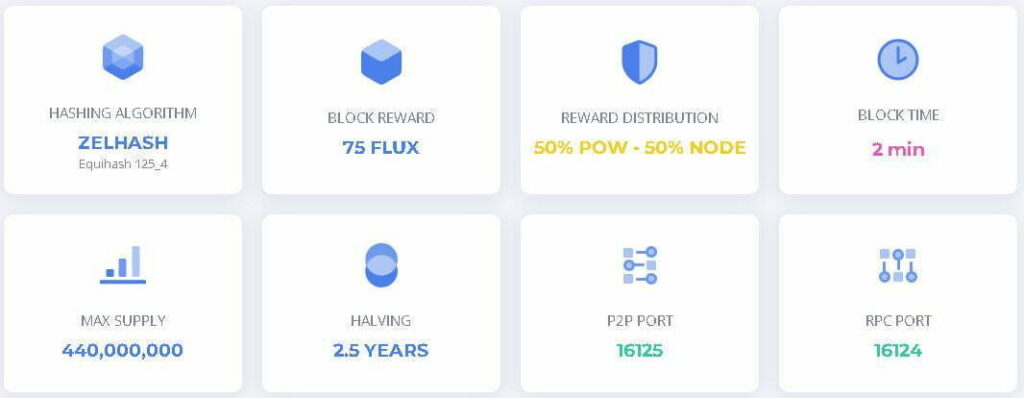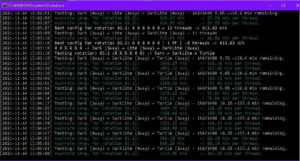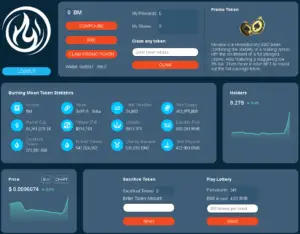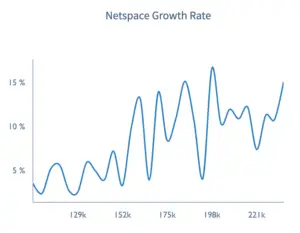What Is Flux?
Flux ($FLUX) is a GPU-mineable cryptocurrency that seeks to be the AWS of Web3, so to speak. Flux aims to provide decentralized cloud computing services by incentivizing Flux holders to set up servers across the world. It currently boasts over 2,600 nodes, over a petabyte (1000TB) of SSD space, over 42TB of memory, and 13,748 CPU cores.
This crypto began as ZELcash in 2018, but in early 2021 developers hard forked it to create what’s now known as Flux.
Like all GPU-mineable coins Flux utilizes a proof-of-work consensus mechanism. In this instance, it uses the ZelHash algorithm, a modification of the Equihash algorithm that seeks to be ASIC and FPGA-resistant, preventing the over-centralization of hashing power.
See Also: The Best Coins to GPU-Mine
Flux differs from other POW coins like Bitcoin or Ethereum in that the block rewards are split differently. Instead of all block rewards going to miners, rewards are split 50-50 between nodes and miners. Flux’s supply is capped at 440 million, and block rewards halve every 2.5 years.
A number of dApps are already built on Flux, with many more under development. Some of the most notable include Presearch, Nitter, and KADDEX.

Flux currently sits at a fairly modest (as cryptocurrencies go) valuation of $429 million, while its fully diluted market cap is about twice that at $834 million. That’s enough to make it the 146th-ranked crypto by market cap, so although far from guaranteed there’s certainly potential for growth.
- ~60MH/s Ethash
- ~61 H/s ZelHash
- ~28 MH/s ProgPow
ZelCore Wallet
One of Flux’s greatest achievements is its ZelCore wallet. It has a number of useful features including the ability to connect to your favorite exchange via API and perform swaps in-app. Supported CEXes include KuCoin, FTX, FTX US, Gemini, Gate.io, and Stex, while other leading exchanges like Coinbase Pro, Binance, Huobi, Kraken, Bittrex, and AscendEX are available with Zelcore+ (their $4/month subscription service).
See Also: How to Mine Cryptocurrency: The Essential Guide

ZelCore has a number of other integrated apps. The most notable of these are Fusion, Purchase Crypto, and FluxNodes.
Fusion is a bridge that enables users to send Flux cross-chain to Kadena, Ethereum, Binance Smart Chain, Tron, and Solana. Alternatively, Flux on other blockchains can be bridged back to the Flux network.
Purchase Crypto is exactly what it sounds like; users can purchase any of seventeen supported assets with a debit or credit card, which are deposited directly to the specified Flux address. It’s an easy way to move assets in quickly. Fees tend to be $20-25 so this usually isn’t your best option unless time is of the essence.
Lastly, FluxNodes allows easy management of any Flux nodes you may be hosting. You can also view the makeup of nodes around the world with a real-time map.
Flux Cross-Chain Assets and Parallel Mining
Tokenized representations of Flux exist on several different blockchains: Kadena, Ethereum, Binance Smart Chain, Tron, and Solana. Users can bridge to and from these chains at will with the Fusion app, but no new Flux is created this way. In other words, Flux’s maximum supply of 440 million is the combined sum of Flux across all six of these chains.
Miners can receive additional FLUX in the form of these cross-chain assets, which are paid out by some pools, most notably MinerPool. At the time of writing, this boosts Flux mining profits by 39%.

Setting Up ZelCore Wallet
Before you got to mining you’ll need a wallet set up so that there’s an address to mine to. ZelCore wallet is one of the best options when mining Flux, so you’ll want to download it from their website. Alternatively, if you’re mining Flux and immediately selling you may want to mine directly to an exchange wallet.
Once ZelCore is installed and running, you’ll be prompted to create an account. Do so and you’ll arrive at the main interface.
To find the Flux address you’ll be using for mining, navigate to the Portfolio tab on the far left side of the screen. You’ll see a page displaying a number of automatically-generated wallets:

Pick whichever one you’d like to use. Mining seems like the natural choice in this case, so click on that one or another of your choice.
Next, we’ll need to add Flux as a supported currency in this wallet. Select Manage Assets towards the center of the screen. Next, click Add Assets, then select Flux (FLUX).

Now that you’ve added it to your wallet, click on Flux in your assets page. Select Receive in the menu that appears and you’ll see a QR code with your address below. Copy this and save it for later.
Best Software for Flux Mining
There are three main miners for Flux: GMiner, lolMiner, and miniZ. MiniZ is by far the best option, as it achieves significantly better hashrates than GMiner and lolMiner on average.
How to Mine Flux
With all of that out of the way, let’s take a look at how to mine Flux. Setting up your miner isn’t too difficult, just follow these steps:
Download Miner
Pick a mining software and download the correct build for your OS. As mentioned earlier, we highly recommend miniZ for its impressive hashrates, but GMiner and lolMiner are viable options as well.
Next, extract all zipped files to an easily accessible folder. The .zip file for MiniZ is password-protected, so when you extract the files you’ll need to enter the password: miniZ.
Your antivirus software may flag your miner. This is normal; all three of these apps have been thoroughly vetted and aren’t harmful to your PC.
Select a Pool
For small-scale miners pool mining is the most lucrative option by far. Winning a block is like winning the lottery, and unless you have a significant percentage of the tickets you’re unlikely to win. Pooling takes the luck out of mining by combining your resources with other miners. The result is a far steadier stream of income.
There are a number of pools to choose from; you can view a list of the options on this page. We recommend MinerPool or FluxPools.
Configure Flux Mining Batch File
Open the folder that contains all of your miner files. Right-click in the folder and navigate to New>Text Document. In Linux the wording may differ slightly but the process remains roughly the same.

Rename this file to mineFlux.bat or something similar. The key point is to change the extension from .txt to .bat, as you need a batch file to configure and run the miner.
Finally, open the file in Notepad or another text editor. Depending on your choice of miner, the syntax will vary slightly. Regardless of your software, you’ll need to know the specific server and port you’ll be connecting to. This varies from pool to pool, and is usually listed on the pool’s website.
MinerPool has one port for weaker cards (approximately weaker than a 1070 Ti, or less than 50 sol/s) and one for more powerful GPUs. Pick the one that seems appropriate. Below are the servers and ports, sorted by region. Port 2032 is for weaker cards, while 2033 is for better ones.
flux-us-east.minerpool.org:2032
flux-us-east.minerpool.org:2033
flux-eu.minerpool.org:2032
flux-eu.minerpool.org:2033
flux-us-west.minerpool.org:2032
flux-us-west.minerpool.org:2033
flux-asia.minerpool.org:2032
flux-asia.minerpool.org:2033
These are the different server options for FluxPools:
us-flux.fluxpools.net:2001
us-flux.fluxpools.net:7001
us-flux.fluxpools.net:7011
us-flux.fluxpools.net:7111
us-flux.fluxpools.net:7201
us-flux.fluxpools.net:7711
eu-flux.fluxpools.net:7011
eu-flux.fluxpools.net:7711 With your server address and port in hand, it’s time to configure the .bat files. The exact syntax will vary based on your miner, but we’ll cover all three:
miniZ
miniZ.exe --url=<ADDRESS>.<WORKERNAME>@<SERVER>:<PORT> -p <PASSWORD> --par=125,4 --pers=ZelProofThus, an actual miniZ batch file should look something like this (except that the password should be more secure):
miniZ.exe --url=t1KvzVuqgFSGtm3eELnamVg9c4GfDSQDQDV.RTX3080Ti@us-flux.fluxpools.net:2001 -p password --par=125,4 --pers=ZelProofGMiner
miner.exe --user <ADDRESS>.<WORKERNAME> --server <SERVER> --port <PORT> --pass <PASSWORD> --algo 125_4 --pers ZelProofAnd a real-life example:
miner.exe --user t1KvzVuqgFSGtm3eELnamVg9c4GfDSQDQDV.RTX3080Ti --server us-flux.fluxpools.net --port 2001 --pass password --algo 125_4 --pers ZelProofLolMiner
lolMiner.exe --user <ADDRESS>.<WORKERNAME> --port <PORT> --pool <SERVER> --pass <PASSWORD> --coin fluxThe finished product will look like so:
lolMiner.exe --user t1KvzVuqgFSGtm3eELnamVg9c4GfDSQDQDV.RTX3080Ti --port 2001 --pool us-flux.fluxpools.net --pass password --coin fluxIf you’re on Linux the scripts will remain the same except for the call miner.exe, which should be changed to miner.
Once you’ve copied and pasted the script and adjusted the variables to suit your needs, save the .bat file.
Run the Miner
Now, all that’s left to do is run your miner. Double-click on FluxMiner.bat and you should see a screen similar to the one below:

Your hashrate (measured in Sol/s) will display, as well as your GPU temperatures. Just like that, your Flux mining operation is up and running.
How to Sell Flux
Once you’ve mined a decent amount of Flux, you may want to take profits. If you want to convert to fiat, the easiest way to do so is through a CEX like KuCoin or Gate.io. Deposit Flux to your CEX wallet, either by mining directly to it (by entering your deposit address in your miner’s batch file) or by sending it from the ZelCore wallet.
From there, it can easily be exchanged for Tether or Bitcoin. Lastly, send this cryptocurrency to an app like Coinbase, Binance, or Crypto.com where you can cash it out for fiat.
If you’re okay keeping your money “in the Matrix” Flux can be bridged to virtually any chain through one or more jumps. Converting Flux to its BSC equivalent is probably your best bet, since the Binance Smart chain is well-connected to other chains and has fairly low gas fees.
The Best Flux Mining Rig (Parts List)
If you’re looking to mine Flux but don’t have a PC yet, we have you covered with a fully compatible parts list that’s competitively priced to make ROI as quick as possible. Keep in mind that this parts list is for small-scale miners. If you’re looking to build a multi-GPU setup you’ll be better off opting for a rig with a mining-oriented motherboard and a high-end PSU.
This PC build doubles as a strong gaming PC that’s ideal for 60-144FPS in most games at 1080p. Its Flux hashrate will be around 80 Sol/s. Depending on pricing, the RTX 3070 may be a better deal with its hashrate of approximately 61 Sol/s. Check prices before buying and, most importantly, make sure that your chosen card isn’t an LHR make.
| Component | Model | Price |
|---|---|---|
| CPU | Core i3-10100F (With Stock Cooler) | Check Price |
| Graphics Card | Nvidia RTX 3080 FE | Check Price |
| Motherboard | Asus Prime H410M-A | Check Price |
| RAM | Silicon Power 2x8GB 3200MHz C16 DDR4 | Check Price |
| Storage | PNY CS900 250GB SATA SSD | Check Price |
| Power Supply | EVGA SuperNova 750 GT Gold | Check Price |
| Case | Montech AIR 1000 | Check Price |




